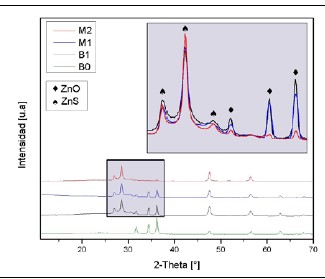Resumen
Actualmente se realizan investigaciones a nivel mundial para desarrollar nuevos materiales con propiedades adecuadas para la fabricación de dispositivos fotovoltaicos, con el fin de obtener energía de fuentes renovables y reemplazar las convencionales. Por motivos ambientales los materiales deben ser abundantes y no ser contaminantes, requisitos que el sulfuro de zinc (ZnS) cumple. En este estudio se sintetizaron películas delgadas de ZnS por el método sol-gel para evaluar el efecto de algunos precursores de zinc y azufre, de los agentes complejantes, así como del tratamiento térmico a 500 °C en la obtención del ZnS. os sólidos obtenidos y tratados en atmósfera oxidante se caracterizaron mediante difracción de rayos-X (XRD), lo que permitió establecer el protocolo de reacción más adecuado para la preparación del ZnS y depositar recubrimientos de ZnS sobre sustratos de vidrio-cuarzo usando la técnica de recubrimiento por centrifugación (spin coating). Las películas también se sometieron a un tratamiento térmico basado en nitrógeno gaseoso y azufre elemental. Los recubrimientos de ZnS se caracterizaron con XRD, microscopía electrónica de barrido (SEM), espectroscopía dispersiva de rayos X (EDS) y espectroscopía UV-Vis. Los resultados evidenciaron que las películas depositadas presentan propiedades adecuadas para ser empleadas como capa amortiguadora en celdas solares.
Referencias
Botero, M., Gordillo, G., Calderón, C. (2013). Preparación y estudio de películas delgadas de ZnS y ZnS: In. Revista Colombiana de Física. 45 (2):168-171.
Goktas, A., Aslan, F., Yasar, E., Mutlu, I. H. (2012). Preparation and characterization of thickness dependent nano-structured ZnS thin films by sol–gel technique. Mater. Electron. 23: 1361-1366.
Gómez-Barojas, E., Sánchez-Mora, E., Castillo-Abriz, C., Flores-Rodríguez, E., Silva-González, R. (2013). Synthesis and Study of Optical and Photocatalytic Properties of Mn and Sm Doped ZnS Grown by Sol-Gel. Journal of Superconductivity and Novel Magnetism. 26: 2337-2340.
Green, M. A., Dunlop, E. D., Levi, D. H., Hohl-Ebinger, J., Yoshita, M., Ho-Baillie, A. W. Y. (2019). Solar cell efficiency tables (version 55). Progress in Photovoltaics: Research and Applications. 27: 565-575.
Hurma, T. (2018). Structural and optical properties of nanocrystalline ZnS and ZnS:Al films. Journal of Molecular Structure. 1161: 279-284.
Husain, A. A. F., Hasan, W. Z. W., Hamídon, M. N., Pandey, S. S. (2018). A review of transparent solar photovoltaic technologies. Renewable and Suistainable Energy Reviews. 94: 779-791.
Hyun, D., Hoon, J., Nam, K., San, K., Guk, Y. (2012). Structural and optical properties of ZnS thin films deposited by RF magnetron sputtering. Nanoscale Res Lett. 7 (1): 26-32.
Kabir, E., Kumar, P., Kumar, S., Adelodun, A., Kim, K. (2018). Solar Energy: Potential and future prospects. Renewable and Sustainable Energy Reviews. 82: 894-900.
Lee, T. D., Ebong, A. U. (2017). A review of thin film solar cell technologies and challenges. Renewable and Suistainable Energy Reviews. 70: 1286-1297.
Liu, W., Yang, C., Hsieh, S., Chen, W., Fern, C. (2013). Effect of deposition variables on properties of CBD ZnS thin films prepared in chemical bath of ZnSO4/SC(NH2)2/Na3C3H5O7/NH4OH. Applied Surface Science. 264: 213-218.
Liu, T., Ke, H., Zhang, H., Duo, S., Sun, Q., Fei, X., Zhou, G., Liu, H., Fan, L. (2014). Effect of four different zinc salts and annealing treatment on growth, structural, mechanical, and optical properties of nanocrystalline ZnS thin films by chemical bath deposition. Materials Science in Semiconductor Processing. 26: 301-311.
Márquez, E., Shaaban, E. R., Abousehly, A. M. (2014). Structural and optical properties of ZnS thin films. Int. J. New. Hor. Phys. 1: 17-24.
Pathak, T., Kumar, V., Purohit, L. P., Swart, H. C., Kroon, R. E. (2016). Substrate dependent structural, optical and electrical properties of ZnS thin films grown by RF sputtering. Physica E. 84: 530-536.
Powalla, M., Paetel, S., Ahlswede, E., Wuerz, R., Wessendorf, C. D., Friedlmeier, T. M. (2018). Thin‐film solar cells exceeding 22% solar cell efficiency: An overview on CdTe-, Cu(In,Ga)Se2-, and perovskite-based materials. Applied Physics Reviews. 5 (4): 1-30.
Reinisch, M., Perkins, C. L., Steirer, K. X. (2016). Quantitative Study on the Chemical Solution Deposition of Zinc Oxysulfide. ECS Journal of Solid State Science and Technology. 5 (2):58-66.
Rodgers, G. E. (1996). Química inorgánica: Introducción a la Química de coordinación, del estado sólido y descriptiva (pp. 663-664). Madrid, España: Editorial Mc Graw Hill.
Skoog, D. A., West, D. M., Holler, F. J., Crouch, S. R. (2005). Fundamentos de química analítica (pp. 1090-1091). Ciudad de México, México: Editorial Cengage Learning.
Swanepoel, R. (1983). Determination of the thickness and optical constants of amorphous silicon. Journal of Physics. E: Scientific Instruments. 16: 1214-1223.
Vargas-Perea, H. A., Rocha-Gonzáles, R., Botero-Londoño, M. A., Sepúlveda-Sepúlveda, A., Calderón, C. L. (2018). Herramienta de software para determinar constantes ópticas en celdas solares tipo película delgada. DYNA. 85 (206): 321-328.
Vasconcelos, P. G., Aguirre, M. O. (2017). Photovoltaic solar energy: Conceptual framework. Renewable and Suistainable Energy Reviews. 74: 590-601.
Vishwakarma, R. (2017). Thickness-dependent structural, electrical, and optical properties of ZnS thin films deposited by thermal evaporation. Ukrainian Journal of Physics. 62: 422-431.
Zhang, R., Wang, B., Zhang, H., Wei, L. (2005). The structure and optical properties of the nanocrystalline ZnS films prepared by sulfurizing the as-deposited ZnO films. Applied Surface Science. 241: 435-441.

Esta obra está bajo una licencia internacional Creative Commons Atribución-NoComercial-SinDerivadas 4.0.
Derechos de autor 2020 Revista de la Academia Colombiana de Ciencias Exactas, Físicas y Naturales

